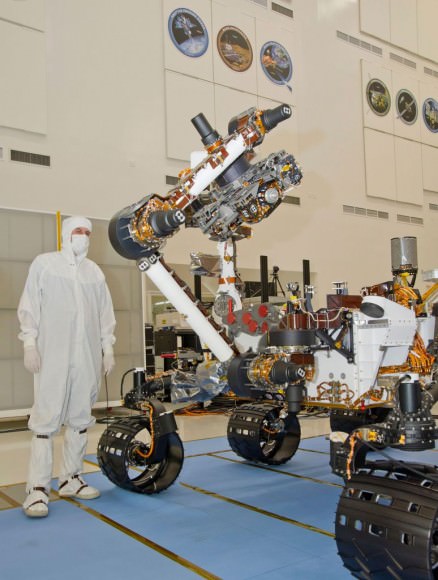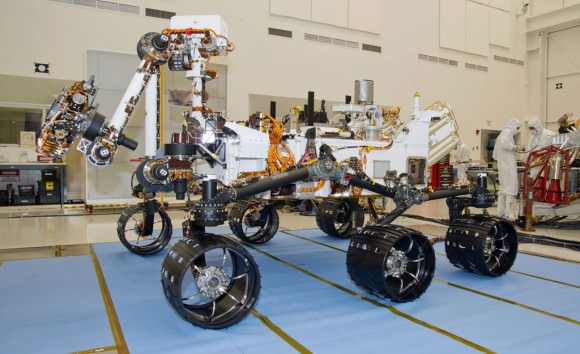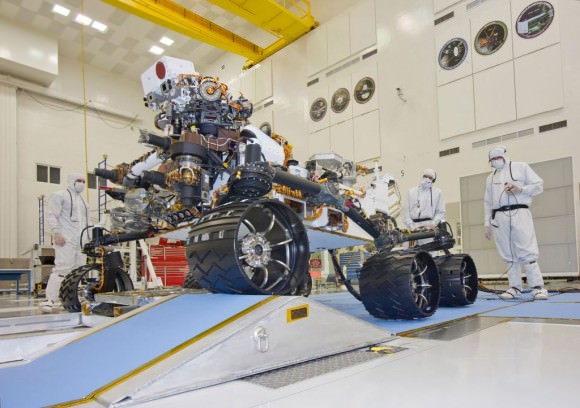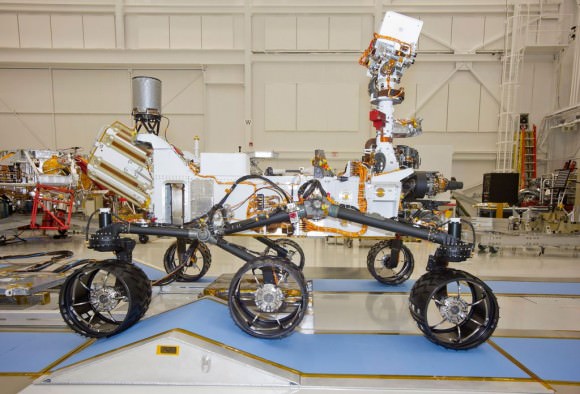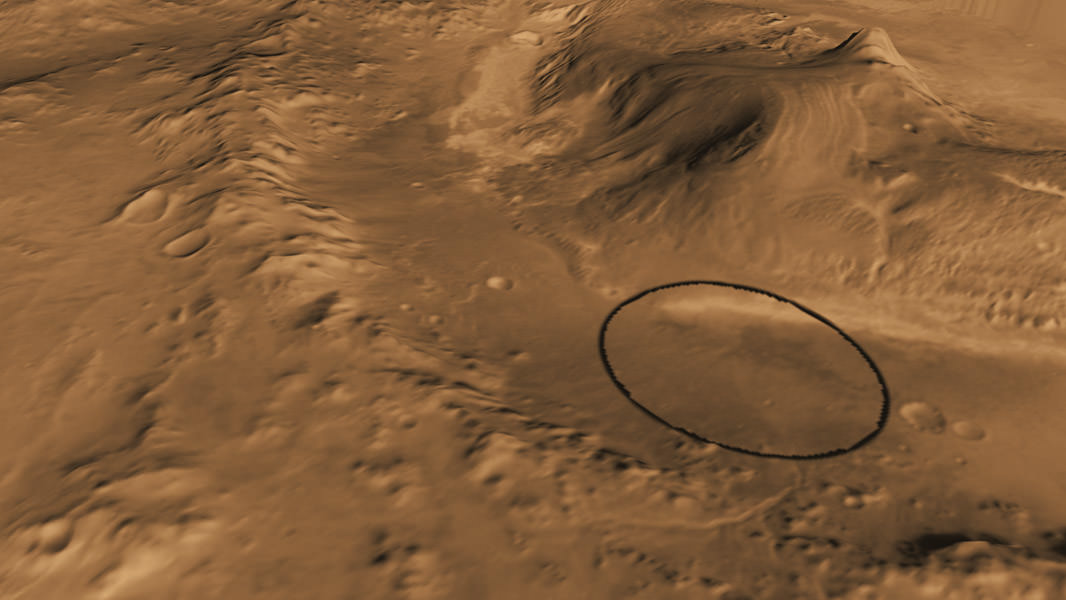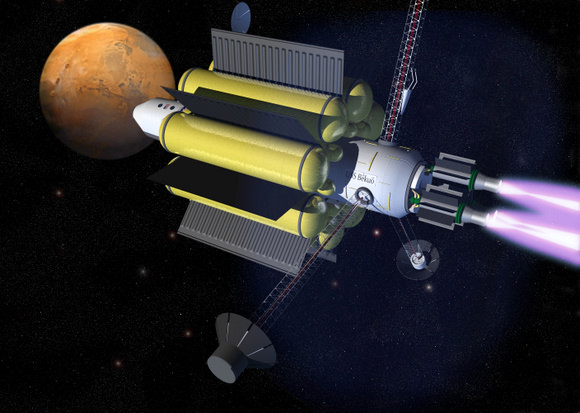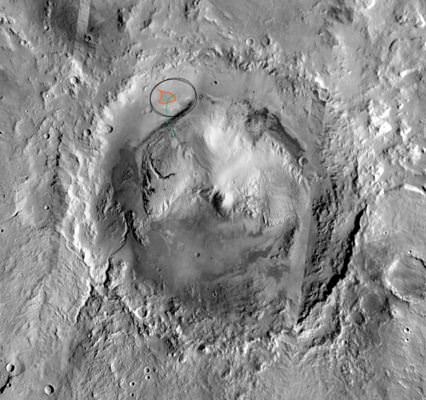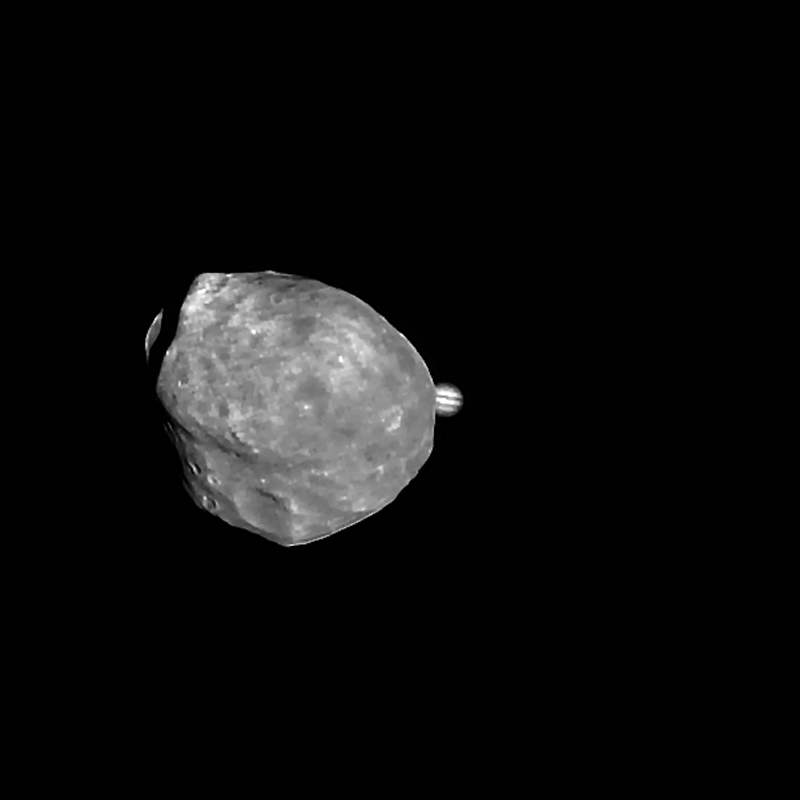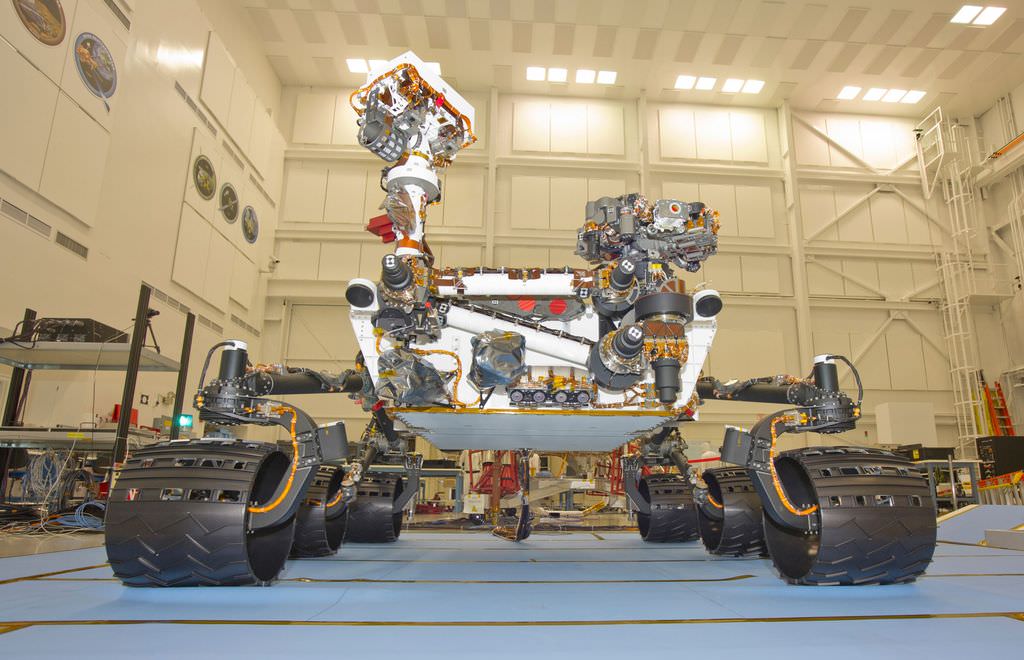Last week scientists, engineers and others who work on the Mars Exploration Rover mission paid tribute to the Spirit rover which explored Mars for six years before succumbing to the harsh Martian winter in 2010. I was away at a conference last week and missed it, but fortunately the event was recorded and you (and I!) can watch it below. Above is a video photo diary of Spirit’s accomplishments on Mars.
Mars Science Lab Rover Will Land in Gale Crater
[/caption]
It’s official: the Mars Science Laboratory rover, Curiosity, will be landing Gale Crater on Mars. Scientists announced the final decision at a special event at the Smithsonian’s National Air and Space Museum Friday morning. Comparing the terrain to an enticing bowl of layered Neopolitan ice cream, the science team announced the rover will land at the foot of a layered mountain inside Gale Crater.
“The science at Gale is going to be amazing and it will be a beautiful place to visit,” said Dawn Sumner, a geologist with the MSL team.
MSL is scheduled to launch in November 2011 from NASA’s Kennedy Space Center in Florida and land in August 2012. Curiosity is twice as long and more than five times as heavy as previous the Mars Exploration rovers Spirit and Opportunity. The rover will study whether the landing region at Gale crater had favorable environmental conditions for supporting microbial life and for preserving clues about whether life ever existed.
News had leaked out a few weeks ago that Gale was the favored site, but scientists today explained what made Gale stand out among the four final candidates, which each offered their own delicious “flavor,” making the decision a difficult one.
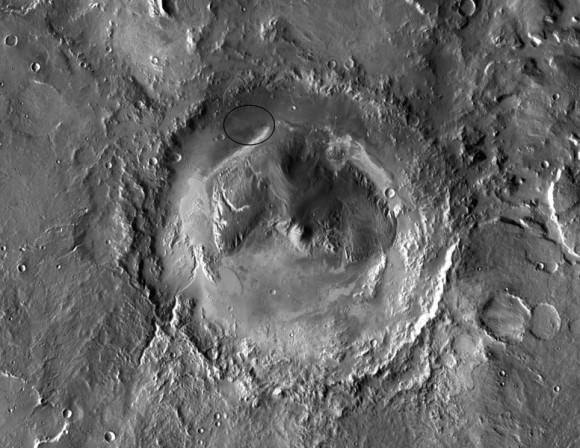
“When it comes down to four landing sites, it comes down to what feels right,” said John Grotzinger, Mars Science Laboratory project scientist. “We as a science team, as a community, we got together and in the end we picked the one that felt best. Why? Here, we’ve got mountain of rocks, taller than Mount Whitney. It looks like Hawaii; it’s not a tall spire, but a broad mound. So we can actually climb up this mountain with the rover. That alone justifies sending the spacecraft there. It turns out, though, the most attractive science sites are at the base of the mountain. We can address the principle goals of the things the Mars community would like answers to.”
NASA’s strategy for Mars has been to “follow the water,” since we know that wherever there is water on Earth, there is life. Scientists are hedging their bets on Mars that wherever liquid water once flowed would be the best places to look for evidence of past habitability.
Gale has that going for it.
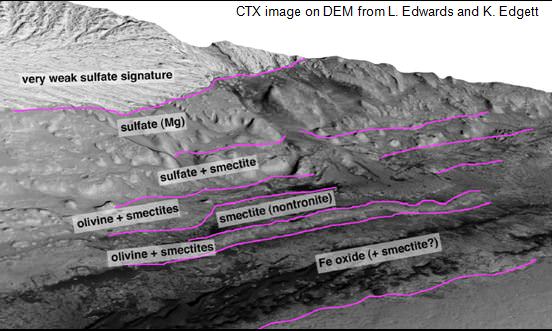
The portion of the crater where Curiosity will land has an alluvial fan likely formed by water-carried sediments. The layers at the base of the mountain contain clays and sulfates, both known to form in water.
“It’s a huge crater sitting in a very low-elevation position on Mars, and we all know that water runs downhill,” Grotzinger said. “In terms of the total vertical profile exposed and the low elevation, Gale offers attractions similar to Mars’ famous Valles Marineris, the largest canyon in the solar system.”
The scientists emphasized that MSL is not a life detection mission, as it can’t look for fossils. But it can detect organic carbon, which can tell the early environmental story of Mars, found in the sediments within rocks.
Gale Crater crater spans 154 kilometers (96 miles) in diameter and is about the combined area of Connecticut and Rhode Island. The mound in the center rises 5 km (3 miles) height and the Layering in the mound suggests it is the surviving remnant of an extensive sequence of deposits.
The crater is named for Australian astronomer Walter F. Gale.
About the size of a Mini-Cooper, Curiosity has 17 cameras and a full color video camera. The mission should offer incredible vistas that will likely wow the public, beginning with the landing, as Curiosity will take a full color, high definition movie as it descends on the “Sky Crane” landing system.
Anyone else ready for this mission to get going?
Zubrin Claims VASIMR is a Hoax
[/caption]
A next-generation plasma rocket being developed by former NASA astronaut Franklin Chang Diaz called the Variable Specific Impulse Magnetoplasma Rocket (VASIMR) has been touted as a way to get astronauts to Mars in weeks rather than months, as well as an innovative, cheap way to re-boost the International Space Station. But in a biting commentary posted on Space News and the Mars Society website, “Mars Direct” advocate Robert Zubrin calls VASIMR a “hoax” saying the engine “is neither revolutionary nor particularly promising. Rather, it is just another addition to the family of electric thrusters, which convert electric power to jet thrust, but are markedly inferior to the ones we already have,” adding, “There is thus no basis whatsoever for believing in the feasibility of Chang Diaz’s fantasy power system.”
The VASIMR uses plasma as a propellant. A gas is ionized using radio waves entering into a plasma state. As ions the plasma can be directed and accelerated by a magnetic field to create specific thrust. The purported advantage of the VASIMR lies in its ability to change from high impulse to low impulse thrust as needed, making it an ideal candidate for a mission beyond low Earth orbit.
Chang Diaz’ company, the Ad Astra Rocket Company successfully tested the VASIMR VX-200 plasma engine in 2009. It ran at 201 kilowatts in a vacuum chamber, passing the 200-kilowatt mark for the first time. “It’s the most powerful plasma rocket in the world right now,” said Chang-Diaz at the time. Ad Astra has signed a Space Act agreement with NASA to test a 200-kilowatt VASIMR engine on the International Space Station, reportedly in 2013.
The tests would provide periodic boosts to the space station, which gradually drops in altitude due to atmospheric drag. ISS boosts are currently provided by spacecraft with conventional thrusters, which consume about 7.5 tons of propellant per year. By cutting this amount down to 0.3 tons, Chang-Diaz estimates that VASIMR could save NASA millions of dollars per year.
For the engine to enable trips to Mars in a reported 39 days, a 10- to 20-megawatt VASIMR engine ion engine would need to be coupled with nuclear power to dramatically shorten human transit times between planets.

Zubrin is the president of the Mars Society and author of the book “The Case for Mars: The Plan to Settle the Red Planet and Why We Must.” He has long touted the “Mars Direct” approach of getting humans to Mars to create a sustainable human settlement. The plan includes a series of unmanned and human flights to Mars using existing technology, as well as “living off the land” on Mars by creating rocket fuel to return to Earth, and using underground reservoirs of water on Mars.
In his commentary on VASIMR, Zubrin says, “existing ion thrusters routinely achieve 70 percent efficiency and have operated successfully both on the test stand and in space for thousands of hours. In contrast, after 30 years of research, the VASIMR has only obtained about 50 percent efficiency in test stand burns of a few seconds’ duration.”
On the ‘39 days to Mars’ claim, Zubrin says VASIMR would need to couple with a nuclear reactor system with a power of 200,000 kilowatts and a power-to-mass ratio of 1,000 watts per kilogram, while the largest space nuclear reactor ever built, the Soviet Topaz, had a power of 10 kilowatts and a power-to-mass ratio of 10 watts per kilogram.
Zubrin has invited Chang Diaz to a formal public debate the VASIMR at a Mars Society convention in Dallas next month.
Read Zubrin’s commentary on Space News or the Mars Society website.
More info: Ad Astra Rocket Company
Landing Site for Next Mars Rover Narrowed to Two
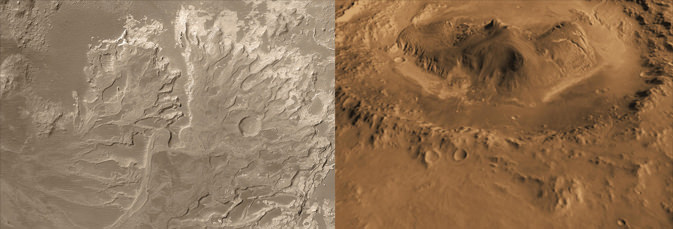
[/caption]
Although a rumor came out about a week and a half ago that Gale Crater was the scientists’ preferred landing site for the Mars Science Laboratory, officially NASA says the finalists are now down to two: Gale and Eberswalde craters. The final selection will likely be made sometime this month, no earlier than July 11. As of now, MSL, a.k.a Curiosity scheduled to head to Mars during a Nov. 25 to Dec. 18, 2011 launch window.
Gale Crater contains ancient lakebed deposits and sitting in the middle of the crater is an enticing 5-kilometer-tall mound of rock, stacked with layers. This could provide the rover a study a variety of environments that produced clay deposits near the mountain’s base to later environments that produced sulfate deposits partway up the slope.
Eberswalde is the site of what scientists think is a former river delta, where organic materials could be waiting to be analyzed. NASA says that as a clay-bearing site where a river once flowed into a lake, Eberswalde crater offers a chance to use knowledge that oil industry geologists have accumulated about where in a delta to look for any concentrations of carbon chemistry, a crucial ingredient for life.
Officially out of the running are Mawrth Vallis and Holden Crater, the other two finalist sites.
The spacecraft will arrive at Mars in August 2012, and land via its unusual “sky crane” landing system. (See a video of it here.) Researchers will use the rover’s 10 science instruments for at least two years to investigate whether the landing area has ever offered environmental conditions favorable for microbial life.
Source: NASA
The Question of Life on Mars Still Intrigues Us
Is there — or was there ever — life on Mars? And will we ever definitively find out? After multiple unmanned missions to Mars, we still can’t answer those questions, but the possibility of life on the Red Planet has intrigued us for decades and our interest in Mars still runs high. Here’s a video produced by the PBS affiliate in San Francisco, California, KQED and their science and environment series QUEST. It looks at our past fascination of Mars and how NASA scientists are hoping the Mars Science Lab rover will help them solve the mysteries of Mars.
Dramatic New NASA Animation Depicts Next Mars Rover in Action
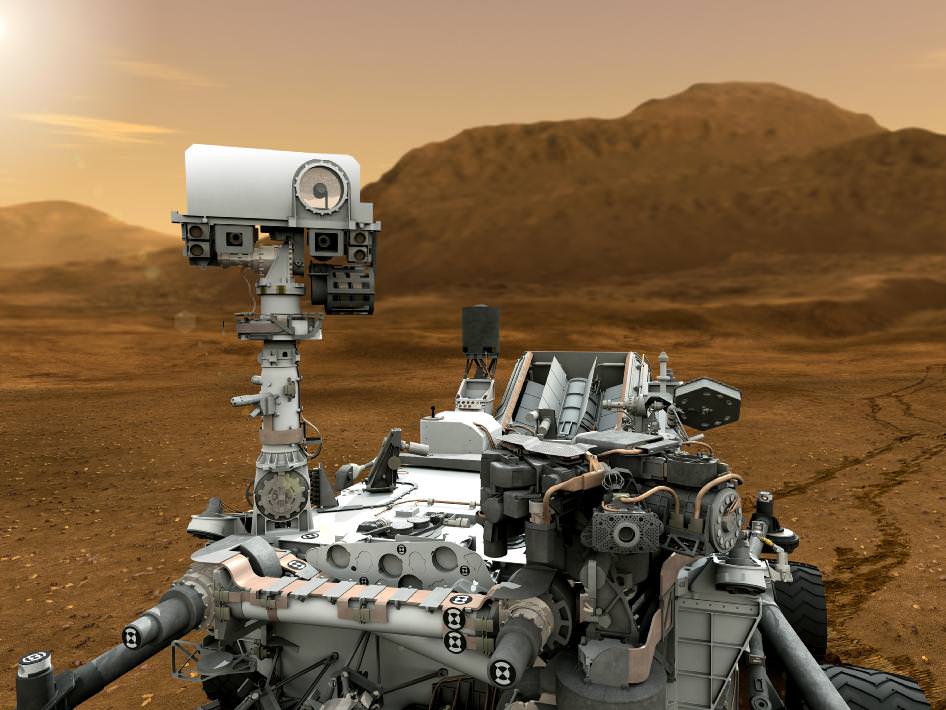
[/caption]
NASA’s next Mars rover, the Curiosity Mars Science Laboratory, will soon embark on a quantum leap in humankind’s scientific exploration of the Martian surface -the most Earthlike planet in our Solar System.
To get a birds eye understanding of Curiosity’s magnificent capabilities, check out the dramatic new high resolution animation below which depicts NASA’s next Mars rover traversing tantalizing terrain for clues to whether Martian microbial life may have existed, evolved and been sustained in past or present times.
The new action packed animation is 11 minutes in length. It depicts sequences starting with Earth departure, smashing through the Martian atmosphere, the nail biting terror of the never before used rocket-backpack sky crane landing system and then progressing through the assorted science instrument capabilities that Curiosity will bring to bear during its minimum two year expedition across hitherto unseen and unexplored Martian landscapes, mountains and craters.
Curiosity is equipped with 10 science instruments. The three meter long robot is five times the weight of any previous Mars rover.
Those who closely follow the adventures of NASA’s Spirit and Opportunity rovers, like myself, will quickly recognize several of the panoramic scenes which have been included to give a realistic feeling of vistas to expect from the car sized Curiosity rover.
Here is a shorter 4 minute animation with expert narration
Along the way you’ll experience Curiosity zapping rocks with a laser, deftly maneuvering her robotic arm and camera mast and retrieving and analyzing Martian soil samples.
“It is a treat for the 2,000 or more people who have worked on the Mars Science Laboratory during the past eight years to watch these action scenes of the hardware the project has developed and assembled,” said Mars Science Laboratory Project Manager Pete Theisinger at NASA’s Jet Propulsion Laboratory, Pasadena, Calif, in a NASA statement. “The animation also provides an exciting view of this mission for any fan of adventure and exploration.”
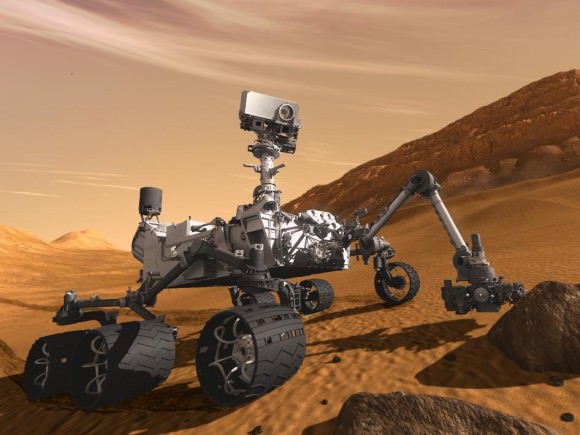
Curiosity rover examines a rock on Mars with a set of tools at the end of the rover's arm, which extends about 2 meters (7 feet). Two instruments on the arm can study rocks up close. Also, a drill can collect sample material from inside of rocks and a scoop can pick up samples of soil. The arm can sieve the samples and deliver fine powder to instruments inside the rover for thorough analysis. Credit: NASA/JPL-Caltech
Curiosity was flown this week from her birthplace at NASA’s Jet Propulsion Laboratory in California to her future launch site in Florida aboard a C-17 military cargo transport aircraft.
She arrived at the Shuttle Landing Facility (SLF) at the Kennedy Space Center on June 22. The SLF is the same landing strip where I watched the STS-135 crew arrive for NASA’s final shuttle mission just days earlier days for their final launch countdown training.
NASA has scheduled Curiosity to blast off for the red planet on Nov. 25, 2011 from Cape Canaveral Air Force Station aboard an Atlas V rocket. Curiosity will touchdown in August 2012 at a landing site that will be announced soon by Ed Weiler, NASA Associate Administrator for the Science Mission Directorate in Washington, D.C.
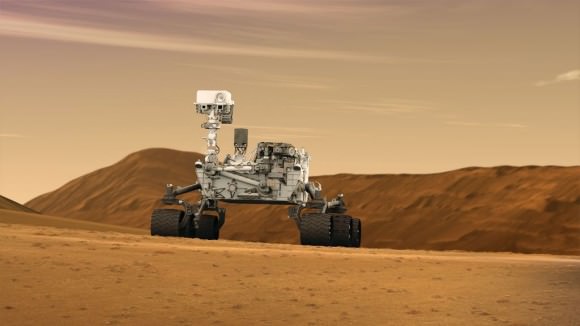
Read my prior features about Curiosity
Packing a Mars Rover for the Trip to Florida; Time Lapse Video
Test Roving NASA’s Curiosity on Earth
Curiosity Mars Rover Almost Complete
Curiosity Rover Testing in Harsh Mars-like Environment
Gale Crater Reported Front-Runner for MSL Landing Site
A 150-kilometer-wide hollow on Mars named Gale Crater has emerged as the front-runner for the potential landing site for the Mars Science Laboratory rover, Curiosity, which will head to Mars this fall. Nature News and the Planetary Society Blog report that following a meeting of project scientists last month, Gale came out on top of four different locations as the preferred destination for the next Mars rover. However, the final decision has not been made or announced, and NASA Associate Administrator Ed Weiler has the final word. He is expected to make the final decision on Friday with a formal announcement of the site to follow next week.
[/caption]
According to planetary scientist Matt Golombek, who was part of the selection committee, Gale Crater has a high diversity of geologic materials with different compositions, created under different conditions. Most interesting is evidence of different minerals arranged in stratigraphical context. “Stratigraphy records multiple early Mars environments in sequential order,” Golombek said at a teleconference for Solar System Ambassadors and Solar System Educators earlier this year. “Gale is characteristic of a family of craters that were filled, buried and exhumed, and will provide insights into an important Martian process.”

The actual landing ellipse is a smooth area with few craters, which is a great and safe place for landing. But the MSL rover – which is the size of a small car – could then take a few 100 sols and head out for more interesting terrain where the sedimentary strata is deposited. There’s a giant 5-kilometer high hill in the middle of the crater, and the rover could traverse up through the lower most layers.
The flythough video of Gale Crater, top, was put together by UnmannedSpaceflight‘s Doug Ellison, who used a mix of HRSC, CTX and HiRISE elevation models, combined with a pair of possible traverse paths for MSL.
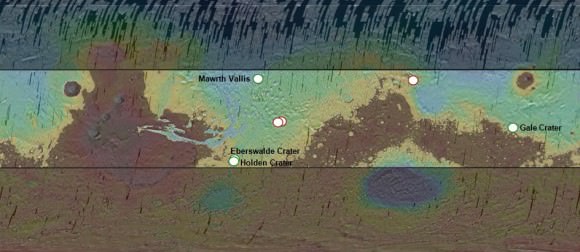
The three other choices also have their good points. All the different landing site choices lie between 30 degrees latitude north and 30 degrees south with low elevations – which is a good thing when trying to land on Mars, Golombek said, because that gives you more of Mars’ thin atmosphere to work with. “All the sites are scientifically rich and safe for landing, with small differences between them,” Golombek said.
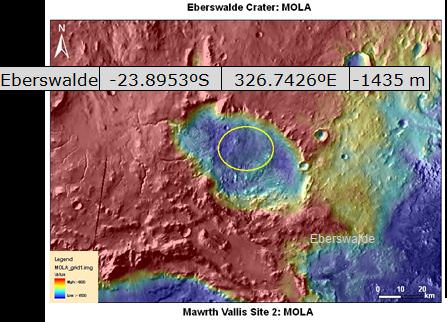
Eberswalde Crater has interesting, rough terrain with flow features that are “clear evidence for a river that entered into a standing body of water at sometime into the past on Mars,” Golombek said. “There’s not much disagreement in science community that this is a ancient delta on Mars.”
This region would provide geologic evidence for how the minerals were deposited and evidence for clay minerals.
“Clays are trappers and preservers of biogenic materials, so going to places where these minerals were deposited in calm water is very enticing,” Golombek said.
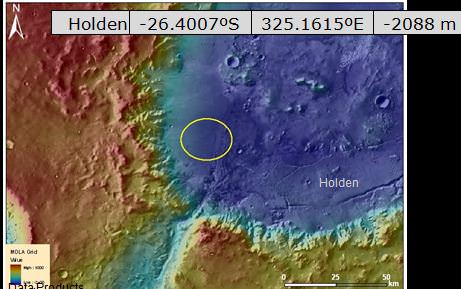
Holden Crater is the smoothest and flattest of the four choices. Southeast of the landing ellipse is an area of minerals that look enticing.
“There are mega breccias – rocks that were thrown up in giant impacts in the earliest days of Mars, so we could study those as well at Holden Crater,” Golombek. “But we’d have to drive pretty far to get there. There are also deposits that were certainly deposited in lake or a relatively quiet fluvial setting.”
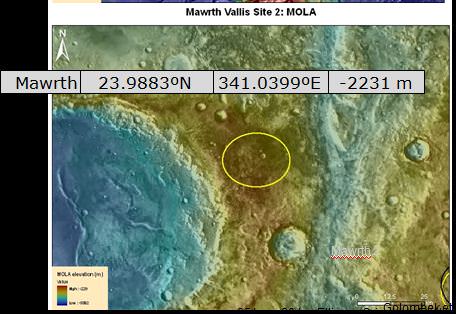
Mawrth Vallis holds complex mineralogy and has some of the oldest and longest sequence of rocks among the four sites and has phyllosilicate-bearing stratigraphy within the landing ellipse. Phyllosilicates, or sheet silicates, are an important group of minerals that includes water-bearing and clay minerals and are an important constituent of sedimentary rocks, which can tell the scientists much about Mars’ past.
Golombek praised the Mars Reconnaissance Orbiter mission for providing a extraordinary amount of data to allow the science team to make the best choice.
“The amount of data we have beforehand is unprecedented in Mars exploration,” he said, “with HiRISE(High Resolution Imaging Science Experiment camera) images at 25 cm per pixel, so we can see one meter-size boulders directly on the surface and we have almost complete coverage of the landing ellipses. CRISM (Compact Reconnaissance Imaging Spectrometer for Mars) provides visible and near infrared data to show minearology. The coverage we have is just spectacular.”
Packing a Mars Rover for the Trip to Florida
Check out this way cool time-lapse movie of NASA’s Curiosity Mars rover as its being packed up for her trip to Florida.
The video covers a 4 day period from June 13 to 17 and is condensed to just 1 minute. Watch the JPL engineers and technicians prepare Curiosity and the descent stage for shipping to the Kennedy Space Center in Florida and place it inside a large protective shipping container. Continue reading “Packing a Mars Rover for the Trip to Florida”
Worlds Apart: Planet and Moon Align
Here’s a cool animation showing Mars’ little moon Phobos passing in front of distant Jupiter from the viewpoint of ESA’s Mars Express orbiter:
The conjunction event occurred on June 1.
[/caption]
Only 21 km (13 miles) across at the widest, the irregularly-shaped Phobos may have been created by a large impact on Mars in its distant past, a chunk of the planet’s crust thrown into orbit. Mars Express most recently performed a close flyby of Phobos back on January 9, passing it at a distance of only 100 km (62 miles).
What’s really amazing to think about is the distances between these two worlds – about 529 million km! But those kinds of distances are no hindrance to vision out in space, especially when the farther object is a giant planet like Jupiter.
The images were taken with Mars Express’ High Resolution Stereo Camera (HRSC), which was kept centered on Jupiter during the conjunction. A total of 104 images were taken over a span of 68 seconds to create the animation.
“By knowing the exact moment when Jupiter passed behind Phobos, the observation will help to verify and even improve our knowledge of the orbital position of the martian moon.”
– ESA
Read the news release on the ESA Space Science site here.
All images shown here were processed at the Department of Planetary Sciences and Remote Sensing at the Institute of Geological Sciences of the Freie Universität Berlin. Credit: ESA/DLR/FU Berlin (G. Neukum)
Test Roving NASA’s Curiosity on Earth
[/caption]
Just over a year from now, NASA’s Curiosity rover should be driving across fascinating new landscapes on the surface of Mars if all goes well. Curiosity is NASA next Mars rover – the Mars Science Laboratory – and is targeted to launch during a three week window that extends from Nov. 25 to Dec. 18, 2011 from Cape Canaveral Air Force Station, Fla..
At NASA’s Jet Propulsion Laboratory (JPL), Pasadena, Calif., engineering specialists have been putting Curiosity through the final phase of mobility tests to check out the driving capability, robotic arm movements and sample collection maneuvers that the robot will carry out while traversing the landing site after plummeting through the Martian atmosphere in August 2012.
Take a good look at this album of newly released images from JPL showing Curiosity from the front and sides, maneuvering all six wheels, climbing obstacles and flexing the robotic arm and turret for science sample collection activities as it will do while exploring the red planet’s surface.
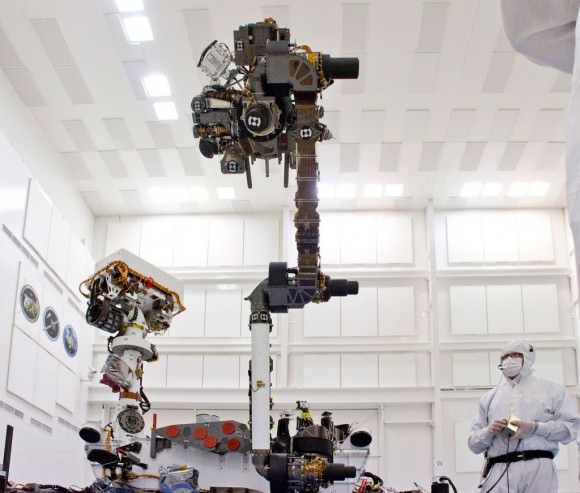
Curiosity is following in the footsteps of the legendary Spirit and Opportunity rovers which landed on opposite side of Mars in 2004.
“The rover and descent stage will be delivered to the Payload Hazardous Servicing Facility at the Kennedy Space Center (KSC) later in June,” Guy Webster, public affairs officer at JPL, told me. An Air Force C-17 transport plane has already delivered the heat shield, back shell and cruise stage on May 12, 2011.
“The testing remaining in California is with engineering models and many operational readiness tests,” Webster elaborated. “Lots of testing remains to be done on the flight system at KSC, including checkouts after shipping, a system test, a fit check with the RTG, tests during final stacking.”
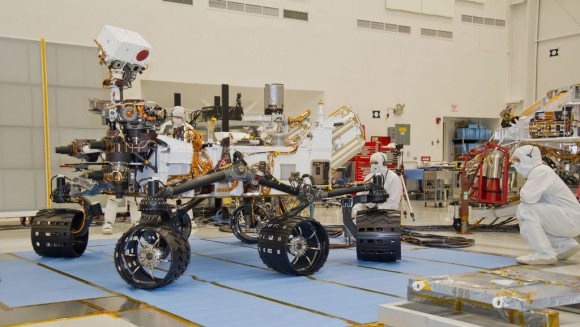
The three meter long rover will explore new terrain that will hopefully provide clues as to whether Mars harbored environmental conditions that may have been favorable to the formation of microbial life beyond Earth and preserved evidence of whether left ever existed in the past and continued through dramatic alterations in Mars history.
NASA is evaluating a list of four potential landing sites that will offer the highest science return and the best chance of finding a potentially habitable zone in a previously unexplored site on the red planet.
